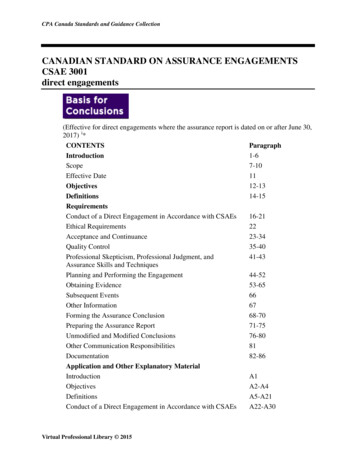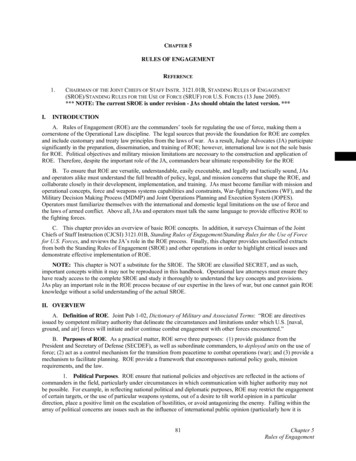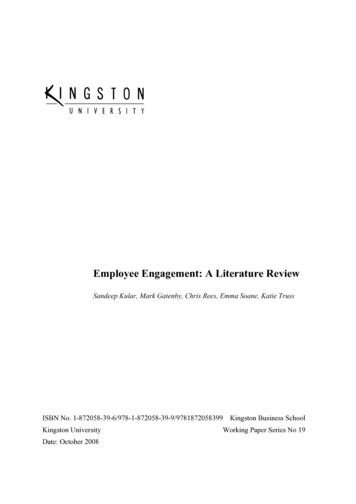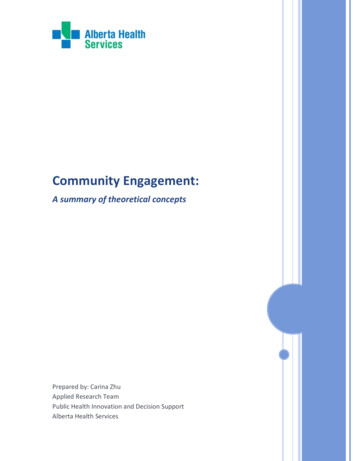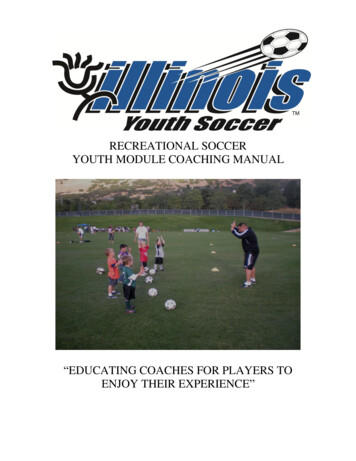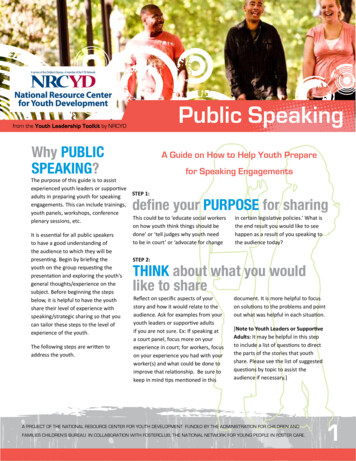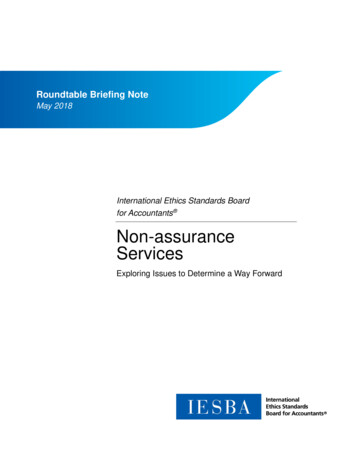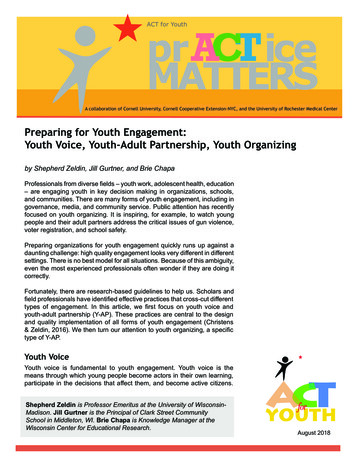
Transcription
ACT for Youth Center of ExcellenceAAcollaborationof borationof CornellUniversity,Universityof Rochester,andandNewState ofCenterfor SchoolPreparing for Youth Engagement:Youth Voice, Youth-Adult Partnership, Youth Organizingby Shepherd Zeldin, Jill Gurtner, and Brie ChapaProfessionals from diverse fields – youth work, adolescent health, education– are engaging youth in key decision making in organizations, schools,and communities. There are many forms of youth engagement, including ingovernance, media, and community service. Public attention has recentlyfocused on youth organizing. It is inspiring, for example, to watch youngpeople and their adult partners address the critical issues of gun violence,voter registration, and school safety.Preparing organizations for youth engagement quickly runs up against adaunting challenge: high quality engagement looks very different in differentsettings. There is no best model for all situations. Because of this ambiguity,even the most experienced professionals often wonder if they are doing itcorrectly.Fortunately, there are research-based guidelines to help us. Scholars andfield professionals have identified effective practices that cross-cut differenttypes of engagement. In this article, we first focus on youth voice andyouth-adult partnership (Y-AP). These practices are central to the designand quality implementation of all forms of youth engagement (Christens& Zeldin, 2016). We then turn our attention to youth organizing, a specifictype of Y-AP.Youth VoiceYouth voice is fundamental to youth engagement. Youth voice is themeans through which young people become actors in their own learning,participate in the decisions that affect them, and become active citizens.Shepherd Zeldin is Professor Emeritus at the University of WisconsinMadison. Jill Gurtner is the Principal of Clark Street CommunitySchool in Middleton, WI. Brie Chapa is Knowledge Manager at theWisconsin Center for Educational Research.August 2018
Most organizations and schools do not seek to maximize youth voice, unfortunately.The imperative is to change this status quo.A necessary first step for organizations is to reflect upon and answer the followingquestions: Is youth voice embedded in the most important things that we do? Whyand where do we most need youth voice within our organization? Do we provideyoung people, on a daily basis, with opportunities to express their views? Do welegitimately give weight and respond to youth opinions? When youth do engage,do we exaggerate their contribution and patronize them or do we show respect bypushing them to step out from their comfort zone?It is critical for staff and youth to explore these core questions in a deep way. Onceconsensus is reached, programming or instruction can be changed accordingly.These questions are simple to ask, yet hard to answer. Your organization must beprepared, therefore, to make time for the ongoing reflection and problem solvingthat is necessary to answer these questions and consider the implications. Thoseorganizations that consistently allocate time are far more likely to successfullymaximize youth voice in a sustainable way.Youth-Adult PartnershipThe term “Youth-Adult Partnership” refers to a group of youth and adults who areworking together for a common purpose. Y-AP reflects the core belief that if we seekto transform oppressive and limiting structures into affirmative and developmentalpractices, we must heed the voices of those most impacted by such structures(Ladson-Billings, 2006; Zeldin et al., 2013). In the Y-AP model, youth and adultsjointly identify the issue, design possible solutions, and implement these solutions.Within community organizations, Y-AP typically focuses on governance and programplanning. Youth and adults also work together on delivering workshops, conductingresearch, and fundraising. Within schools, Y-AP often focuses on issues such ascurriculum redesign, classroom practices, discipline policies, and school-communitycollaborations.Youth voice reaches its potential only when there are adults who are willing andable to be real partners with youth. This reality is illustrated by findings from arecent study conducted inMalaysia, Portugal, andthe United States (figure1). The study measuredyoung people’s belief intheir ability to effect change(“empowerment”) and theirsense of connection to theircommunities (“communityconnectedness”) within thecontext of community-basedyouth programs. Those youthwho strongly believed thatthey had a powerful voice inmaking program decisions(“high voice”) were very likelyACT for Youth2www.actforyouth.net
to also feel personally empowered and emotionally connected to their communities.But those youth who experienced high voice and who also experienced adults astheir partners (“high supportive adult relationships”) were even more likely to feelempowered and connected (Zeldin et al., 2017).The same results were found in a study of high school youth in the United States(figure 2). Those students who experienced high voice were most likely to becognitively engaged in their schoolwork. However, when studentsalso perceived that their teachershad created a sense of safety andsupportive relationships, they alsoexperienced a high level of emotionalconnection and mattering, whichin turn contributed to even moreengagement in their schoolwork(Zeldin et al., 2018).Adults have a hard time beingpartners. Sometimes we take overand dominate. Sometimes weabdicate our own ideas and expertisein the mistaken belief that this is howyouth voice rises. On the contrary,being prepared for Y-AP meansbeing willing to work in a reciprocalmanner with youth and to have highexpectations for performance. Y-APworks when adults teach young people things, be it new skills or viewpoints, they didnot know before. At the same time, adults learn things from youth that they did notknow before. If this is happening in an authentic way, your Y-AP will be successful.This does not mean that youth and adults have equal power. The aim is to allocatereal power and influential roles among diverse people, including those of differentage. Ultimately, the guiding principle is that all Y-AP members, younger and older,have the opportunity to participate in a way consistent with their own choices, skills,and time availability. The aim is to ensure that everybody’s strengths are fully utilized,not hidden. When this happens, power hierarchies become flattened. Healthyorganizations and schools require the engagement of everybody.Y-AP means that adults will have to be prepared to be challenged by youth. As youthfind their voice, they will demand to be heard. There will be frequent negotiationsover the project direction, goals, and time-scale. And, of course, youth will also needto be prepared to be challenged by adults. Creating organizational structures andnorms for group decision making and conflict resolution are therefore fundamentalto preparation.Being prepared for Y-AP also means investing time to garner the active supportof influential adults (e.g., agency directors, school superintendents, communityleaders). These persons may be highly skeptical or unaware of the benefits of youthACT for Youth3www.actforyouth.net
voice and partnership (see sidebar). Being preparedto detail the outcomes of Y-AP will be essential togetting these persons on board with your initiative.Youth OrganizingYouth organizing is a specific type of Y-AP. It is similarto community organizing, the primary difference beingthat youth take on key leadership roles alongsidetheir adult partners. But the aim is the same: to buildnetworks of local residents and institutions that serveas a catalyst for changing oppressive structures andpractices within community and educational systems.Benefits of Youth-Adult PartnershipIt has long been known that Y-AP promotesyouth agency, belonging, competence,and community (Zeldin et al., 2013). Remy(2013) has synthesized the research to alsoshow that involving youth in decision makinghelps organizations create optimal learningenvironments for all. It contributes substantiallyto improved services, more service utilization,and improved youth-adult interactions.Staff gain a greater understanding of youthdevelopment, improved skills in engaging youth,and a stronger motivation and commitmentto working with young people. Ultimately, thepractice of Y-AP strengthens the organizations’reputation and links with other organizations,and advances its own organizational learningand governance.Youth organizing has traditionally been situated inhigh schools. The focus of activism has been as clearcut as improving cafeteria meals or as complicated ascurriculum reform. When organizing happens withinthe school, teachers serve as advisors. Other expertsare often brought in to assist. More recently, youthorganizing has also been initiated by communityorganizations as part of their social justice mission.The majority of these initiatives are still centered on education issues. Youth andtheir adult partners have also found common purpose in issues of the environment,adolescent health, public safety, and criminal justice.Organizations embarking on youth organizing must be prepared to establishrelationships with public and private entities outside their own walls. The key tasksof organizing – issue identification, coalition building, public awareness, collectiveaction – are complicated and require capacities that typically exceed what a singleorganization or age group can offer. Consequently, most youth organizing is fundedby private grants and donations. When partnership is achieved, youth organizing ispowerful, as Blinder and colleagues (2018) have illustrated in their analysis of localMarch for Our Lives rallies. They write that the demonstrations “represented twintriumphs: of organic, youthful grassroots energy, and of sophisticated, experiencedorganizational muscle. . . . Although the events . . . were inspired and often led bystudents, many protests simultaneously benefited from groups with more financialresources and organizational skills than the teenagers had on their own.”Action research and other types of “intelligence gathering” have become a centralcomponent of youth organizing (Christens & Dolan, 2011). Organizations must beprepared to help youth collaborate with teachers or professional researchers in theformulation of research questions, data collection, analysis, and presentations.Organizing is always controversial. Therefore, youth and adult partners as well astheir sponsoring organizations have to be prepared for push-back. Subsequent to theMarch for Our Lives rallies, for example, many youth organizers have been bulliedand isolated from peers, especially in rural areas supportive of gun rights (Healy,2018). The implications are straightforward. Adult partners and youth organizershave to be fully prepared to deal with backlash, especially after public events ordissemination efforts.ACT for Youth4www.actforyouth.net
A Y-AP ChecklistPreparation for quality Y-AP is at the heart of any youth engagement effort. It isnecessary to establish a clear set of goals that define quality Y-AP in your organization.Being prepared means establishing and using processes for monitoring your progresstoward these goals. One way to do this is to consider the cross-cutting best practicesof Y-AP that have been identified by research (see checklist). Working consistentlytoward these criteria will result in quality. Success will come most quickly if youidentify and monitor the best practices that are most meaningful to your organization,the adults, and the youth.ACT for Youth5www.actforyouth.net
ConclusionPreparing for youth engagement requires central attention to youth voice and adultpartnership. Less is more. To prepare for youth engagement, it is best to directchange efforts toward a limited number of organizational functions or programs.Trying to do it all at one time rarely works. Continuous improvement – plan, do,reflect, and repeat – will be the best preparation strategy. By carefully selecting yourmost important goals, using the checklist as a guide, you can embark on a processtoward full youth engagement. The positive benefits of voice and partnership aremaximized over time.Practical ResourcesPromoting children’s participation in democratic decision insight6.pdfPublished by the United Nations Children’s Fund, this guide is anessential resource, perhaps the best one out there.Being Y-AP Savvy: A primer on creating and sustaining youthadult /n y-ap-savvy.pdfThis action-oriented manual is highly relevant for organizations thatwant to begin or to strengthen partnership efforts.Youth-Adult Partnerships in Evaluationhttp://www.actforyouth.net/resources/n/n yap-eval-guide.pdfThis resource guide offers tip sheets on all aspects of participatoryevaluation conducted with youth.Youth and Adult Leaders for Program Excellence (YALPE)http://www.actforyouth.net/resources/n/n yalpe-workbook.pdfIn this kit you’ll find resources and tools for conducting, analyzing, andreporting on program assessment and action planning.ACT for Youth6www.actforyouth.net
ReferencesBlinder, A., Bidgood, J., & Wang, V. (2018, March 25). In gun control marches,students led but adults provided key resources. The New York Times.Retrieved h-organizers.htmlChristens, B., & Dolan, T. (2011). Interweaving youth development, communitydevelopment, and social change through youth organizing. Youth & Society,43, 528-548. s, B., & Zeldin, S. (2018). Community engagement. In R. Levesque (Ed.)Encyclopedia of Adolescence (2nd ed.). New York: Springer.Healy, J. (2018, May 22). ‘Almost no one agrees with us’: For rural students, guncontrol can be a lonely cause. The New York Times. Retrieved from gs, G. (2006). From the achievement gap to the education debt:Understanding achievement in U.S. schools. Educational Researcher, 35,4-11. https://doi.org/10.3102%2F0013189X035007003Remy, H. (2013). Organizational outcomes of youth involvement in organizationaldecision making. Journal of Community Psychology, 41, 488-504.https://doi.org/10.1002/jcop.21553Zeldin, S., Christens, B., & Powers, J. (2013). The psychology and practice ofyouth-adult partnership. American Journal of Community Psychology, 51,385-397. -012-9558-yZeldin, S., Gauley, J. S., Barringer, A., & Chapa, B. (2018). How high schoolsbecome empowering communities. American Journal of CommunityPsychology, 61, 358-371. https://doi.org/10.1002/ajcp.12231Zeldin, S., Gauley, J., Krauss, S. E., Kornbluh, M., & Collura, J. (2017). Youthadult partnership and youth civic development. Youth & Society, 49, 851878. https://doi.org/10.1177%2F0044118X15595153ACT for Youth Center for Community ActionBronfenbrenner Center for Translational Research35 Thornwood Drive Cornell University Ithaca, New York 14850607.255.7736 th.netThe ACT (Assets Coming Together) for Youth Center for Community Action is a partnership amongCornell University Bronfenbrenner Center for Translational Research, Cornell University CooperativeExtension of New York City, and the University of Rochester Medical Center Division of AdolescentMedicine. From 2000 - 2017, ACT for Youth operated as the ACT for Youth Center of Excellence.ACT for Youth7www.actforyouth.net
Youth Organizing Youth organizing is a specific type of Y-AP. It is similar to community organizing, the primary difference being that youth take on key leadership roles alongside their adult partners. But the aim is the same: to build networks of local residents and institutions that s
